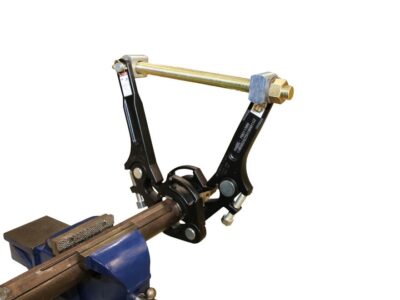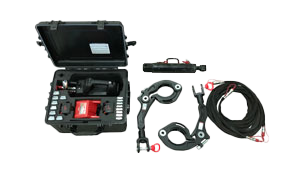Utilizing breakout tongs is a key piece on many horizontal directional drilling jobsites by providing an efficient solution for torqued direct tooling connections.
When it comes to drilling, oftentimes contractors are choosing between the different portable breakout system options available. Let’s take a look at the differences in Vermeer portable breakout system offerings, design advantages and how to determine when to use breakout tongs versus a starter rod.
Device options
The three portable breakout systems offered by Vermeer are the Premium PBD21500, Manual PBD21500MP and PBD11500. The kits share some similarities in the tools offered, but vary in their operation and capabilities.
Before we get started, lets breakdown which drill models these portable breakout systems are designed for, along with their torque capacity:
- PBD21500: D40x55 S3 horizontal directional drill up to the D100x140 S3 horizontal directional drill, with a torque capacity of 21,500 ft-lb (29,200 Nm)
- PBD21500MP: D40x55 S3 horizontal directional drill up to the D100x140 S3 horizontal directional drill, with a torque capacity of 21,500 ft-lb (29,200 Nm)
- PBD11500: D40x55 S3 horizontal directional drills and smaller, with a torque capacity of 11,500 ft-lb (15,600 Nm)
Although these models are what the breakout device tools are specifically designed for, they can be used on any size of drill. All three kit offerings include two die sets that can decrease or expand diameters, and the option to purchase more vice dies for additional sizes if necessary.
First, we’ll take a look at the Premium PBD21500. A key feature in the PBD21500 is the hydraulic power units. Hydraulic portable breakout systems are made efficient to operate with less heavy lifting required. The Vermeer PBD21500 is operated using a 28-volt hydraulic power unit and comes with two lithium batteries, to help minimize the labor involved when making and breaking tooling connections.
The PBD21500MP is similar to the PBD21500, with the biggest difference being the pump style —the PBD21500MP is operated using a manual hydraulic hand pump. Due to the similar applications and kit offerings, the PBD21500MP is a cost-effective option for those who don’t mind making or breaking tooling connections by hand.
The PBD11500 is similar to the PBD21500 but designed for smaller utility directional drilling applications. The PBD11500 is not operated by a hydraulic power unit (like the PBD21500) or with a manual hydraulic hand pump (like the PBD21500MP). Instead, it is operated by adjusting a large screw to torque and untorque your connections.
Design advantages
A major advantage for you in the portable breakout systems are the wrenches. All three kit options come standard with forged alloy wrenches, compared to competitor kits with chain-style wrenches. The forged alloy wrenches are strong and durable, and provide precision when torquing to minimize the risk of under torquing.
Cody Mecham, product manager for Cutting Edge says, “If you tend to use the same rig size with similar diameters, this wrench style can lead to maximum productivity on the jobsite as you may not require as many wrench adjustments due to that similar diameter.”
Storing and transporting your portable breakout system is made convenient with a heavy-duty carrying case. The case is designed with cut outs inside, that can be an obvious way to determine if any pieces are missing when leaving a job site.
Breakout tongs vs. starter rod
If you find yourself debating between using breakout tongs or a starter rod on your jobsite, there are some factors you may need to consider where using breakout tongs may be preferred. The most obvious reason is the size of the drill you are using. Starter rods can only be used on D8x12 horizontal directional drills up to a D40x55. If you have a D60x90 horizontal directional drill or above, starter rods are no longer an option, and breakout tongs will need to be used.
Let’s say you are using a D40x55 S3. Using starter rods and breakout tongs are both options, now what considerations should be made?
The first, is the diameter of the pilot bore. If you are needing to obtain a minimal pilot bore size, utilizing breakout tongs may be more effective. This is because when using a starter rod, a slightly larger hole diameter is needed to accommodate the additional size of the collar.
Secondly, the ground conditions may be better suited for breakout tongs. This is due to highly abrasive ground conditions causing quicker wear on the collar of a starter rod.
The third consideration is the rock reaming capabilities. If you are drilling through rock, less connections may be required, which is when using a reamer over a started rod may be more effective.
Using breakout tongs and starter rods can both be utilized on many HDD jobsites. When it comes down to it, evaluate the size of your drill, ground conditions and tooling capabilities. If you are still undecided, be sure to contact your local dealership or drill specialist to have your questions answered.
Vermeer Corporation reserves the right to make changes in product engineering, design and specifications; add improvements; or discontinue manufacturing or distribution at any time without notice or obligation. Equipment shown is for illustrative purposes only and may display optional accessories or components specific to their global region. Please contact your local Vermeer dealer for more information on machine specifications.
Vermeer and the Vermeer logo are trademarks of Vermeer Manufacturing Company in the U.S. and/or other countries. © 2023 Vermeer Corporation. All Rights Reserved.

